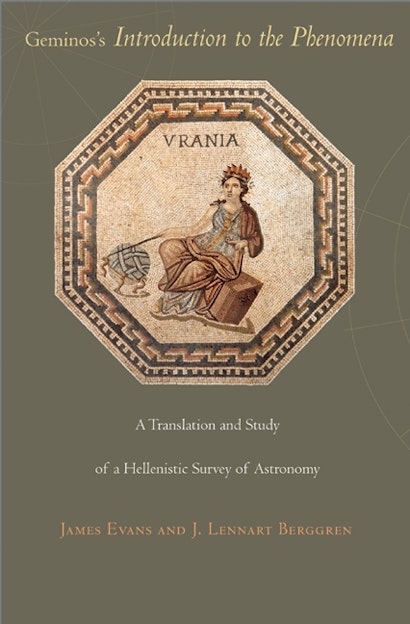This is the first complete English translation of Geminos’s Introduction to the Phenomena—one of the most important and interesting astronomical works of its type to have survived from Greek antiquity. Gracefully and charmingly written, Geminos’s first-century BC textbook for beginning students of astronomy can now be read straight through with understanding and enjoyment by a wider audience than ever before. James Evans and Lennart Berggren’s accurate and readable translation is accompanied by a thorough introduction and commentary that set Geminos’s work in its historical, scientific, and philosophical context. This book is generously illustrated with diagrams from medieval manuscripts of Geminos’s text, as well as drawings and photographs of ancient astronomical instruments. It will be of great interest to students of the history of science, to classicists, and to professional and amateur astronomers who seek to learn more about the origins of their science.
Geminos provides a clear view of Greek astronomy in the period between Hipparchos and Ptolemy, treating such subjects as the zodiac, the constellations, the theory of the celestial sphere, lunar cycles, and eclipses. Most significantly, Geminos gives us the earliest detailed discussion of Babylonian astronomy by a Greek writer, thus offering valuable insight into the cross-cultural transmission of astronomical knowledge in antiquity.
James Evans is codirector of the Program in Science, Technology, and Society at the University of Puget Sound. J. Lennart Berggren is Professor of Mathematics at Simon Fraser University.
"Evans and Berggren's book is an excellent translation and welcome commentary on Geminos's texts. The translation of the Introduction to the Phenomena is a much-needed resource for the study of Hellenistic astronomy, and the introduction, commentary, and appendices the authors provide make the book a useful educational tool accessible to even the most elementary student of the history of astronomy."—Jacqueline Feke, Bryn Mawr Classical Review
"On Geminos, nothing is known. But his text, now available in its entirety in English, thanks to Evans and Berggren, is a critical work for scholars of the history of astronomy and classical studies."—Choice
"The Introduction is an important text that contributes greatly to our understanding of ancient astronomy. . . . Evans and Rerggren have provided valuable discussions and illustrations of the relevant ancient instruments and tools, and the ways in which they were used in the practice of astronomy. . . . Geminos' work is well worth reading, and classicists interested in ancient astronomy will find this book an indispensable resource."—Liba Taub, Classical World
"Evans and Berggren have produced a work that should be on the shelves of all students and scholars interested in the history of early astronomy. Because of the appeal of Geminos's text, this translation will provide a very valuable resource for teaching the history of astronomy and cosmology, as well as early science more generally. The translation is clear, the scholarly apparatus authoritative, and the commentary will serve the needs and interests of a wide range of readers."—Liba Taub, Director & Curator, Whipple Museum, and Reader, Department of History and Philosophy of Science, Cambridge University
"Evans and Berggren have provided both the specialist historian and the general scholar and reader with everything they might need to profit from the text. The introduction has a judicious discussion of the history of the book and its author, its place in the history of astronomy, its intended audience, and the general conceptual framework that it assumes. And the translators have done a splendid job of finding accurate English equivalents of the Greek terms and phrases."—Alexander Jones, University of Toronto
"Everything about this book is excellent. The translation is a model of clarity and the notes to each section explain the text in detail, both technically and historically. The extensive introduction is, by itself, the most detailed account to date of many, perhaps most, of the subjects treated by Geminos. The book will be of use and interest to everyone curious about ancient science, from the student to the specialist. Evans and Berggren have done such an excellent job in every way, their knowledge of the subject is so complete, that I can only admire their work and recommend it as exemplary."—Noel M. Swerdlow, University of Chicago

